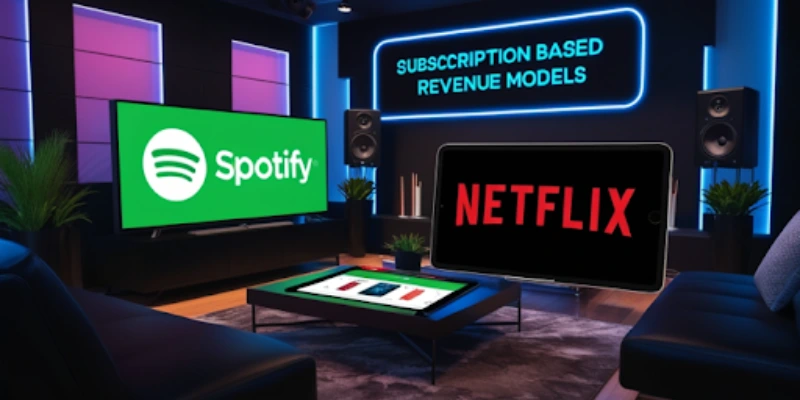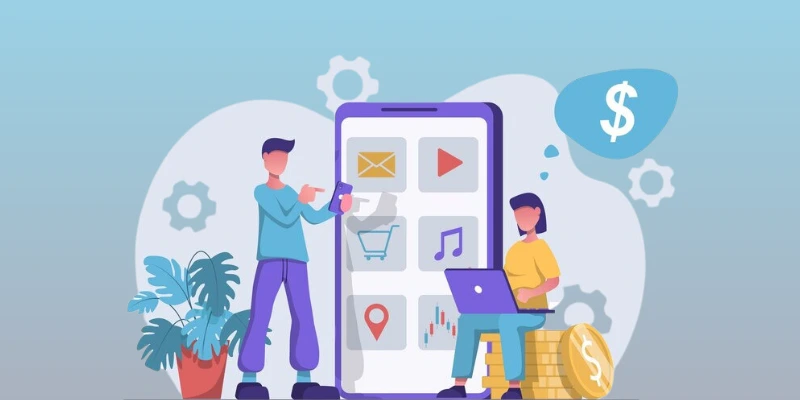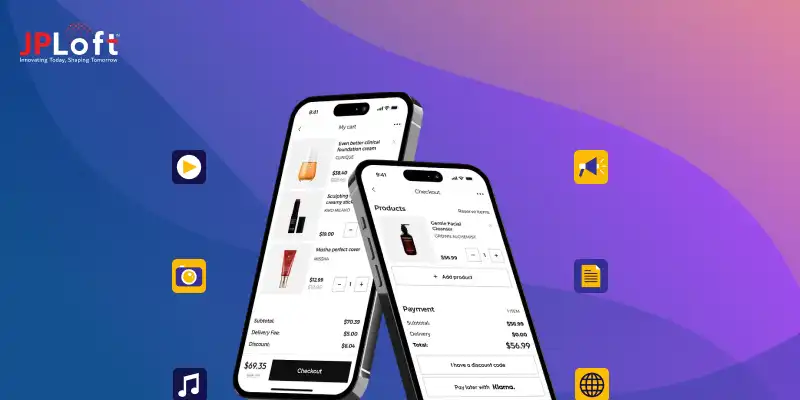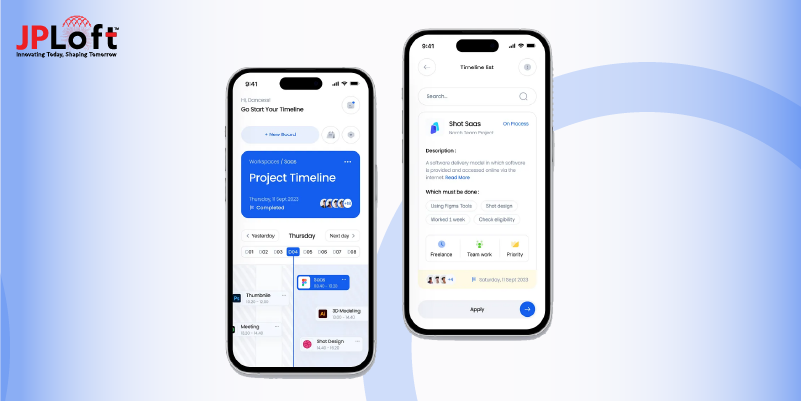80% of apps on the market are free, yet the global app economy generates billions in revenue. Even though apps are so popular, the global app economy makes billions of dollars every year, which shows an interesting trend: free apps can be very profitable if they use good marketing techniques.
A recent study even said that in-app payments made up more than half of all app income in 2023. This shows how different ways of making money, like in-app ads and paid services, could bring in a lot of money.
According to Statista, as of October 2024, nearly 97% of all Android apps and 95.27% of iOS apps are available for free. In-app purchases significantly contribute to this revenue, accounting for over 50% of total app income in 2023.
The global consumer spending on mobile apps reached approximately $35 billion in the second quarter of 2024, underscoring the immense profit potential. Additionally, the mobile app market is projected to grow from $208.5 billion in 2022 to $777.4 billion by 2032, reflecting a robust demand for effective monetization strategies like in-app advertising and subscription services.
By leveraging these methods, free apps can achieve remarkable profitability while remaining accessible to millions of users worldwide.
A top mobile app development company can help you come up with new ways to use mobile devices. We do this by developing both Android and iOS apps. They are experts in the process of making a mobile app and making sure that their strategic marketing plans are perfect for the people they want to reach. Businesses can turn free apps into profitable businesses; they just need to hire dedicated developers and use these ways to make money.
As we learn more about this topic, we will look at the main strategies that help free apps make money while still being available to a lot of people.
The Popularity and Appeal of Free Apps
The dominance of free apps in both the Apple App Store and Google Play Store is a major trend in the mobile app business. This plan allows companies to maximize sales and user interaction, as users are more likely to try an app that doesn’t require upfront payment.
Statistics say that nearly 97% of Android apps and 95.27% of iOS apps are free, confirming this choice.
While free apps draw a larger user base, effective marketing tactics are crucial for turning that audience into income. This is where mobile app developers play a vital part, helping businesses adopt successful income methods such as in-app sales, payments, and ads.
Famous Revenue Models of Free Apps
Advertising: The Most Common Revenue Model
The advertising-based income plan is a cornerstone of many mobile apps, allowing developers to monetize their services while giving free access to users. This model includes various ad types, each suited for different situations and user experiences.
Overview of Ad Types
-
-
Banner Ads: These are rectangular ads presented at the top or bottom of the screen. They are easy to apply and can be used in almost any game. For example, a news app might use flash ads to create revenue while users read through stories.
-
Interstitial Ads: Full-screen ads that show at natural change places in the app, such as between levels in a game. They are effective for catching user interest but should be used rarely to avoid annoyance. A popular mobile game often uses popup ads after finishing a level.
-
Video Ads: These ads can play before, during, or after content and are especially effective in game and video streaming apps. For instance, apps like TikTok utilize video ads to interest users with dynamic content.
-
Native Ads: Designed to mix perfectly with the app’s content, native ads provide a less annoying experience. An example is paid posts on social media sites that match the look and feel of user-generated material.
Challenges and Solutions
Despite their usefulness, ads can lead to user frustration if not merged carefully. Users often hate invasive or useless advertisements, which can distract from their overall experience. To keep a good user experience, writers should focus on proper ad placement and regularity. Implementing user feedback methods can help improve ad strategies, ensuring that ads are relevant and interesting without overwhelming users.
You should hire mobile app developers who understand these factors, businesses can create interesting free apps that also incorporate effective income streams through ads, combining user satisfaction with profitability.
Our mobile app development company focuses on helping customers create these tactics while improving their income potential.
In-App Purchases and the Freemium Model
The freemium model is a popular marketing strategy used by many mobile apps, allowing users to access basic features for free while charging for paid content. This method successfully draws a bigger user base, as possible users are more likely to download a free app.
Once involved, users can choose to improve their experience through in-app payments (IAPs), which can greatly boost income.
Types of In-App Purchases
-
-
Consumable Purchases: These are things that can be bought multiple times and are used up within the app. For example, in gaming apps like Candy Crush, players can buy extra lives or in-game cash to improve their game experience.
-
Non-Consumable Purchases: These things are bought once and stay available forever. An example is creating an AI fitness tracker app that gives paid workout plans or tools that users can access after a one-time payment.
-
Subscriptions: This approach provides users with access to special material or benefits for a set time, often needing regular payments. For instance, streaming services like Spotify give auto-renewable payments for constant access to music.
-
Commercial Element
Companies like JPLoft are experts in adding in-app payments to mobile apps in a way that balances income generation with user happiness. By leveraging our expertise in mobile app development, we help you develop interesting free apps that incorporate effective marketing strategies without compromising user experience.
Benefits for App Owners
The freemium approach allows apps to grow successfully by drawing a broad user base while producing steady income through alternative payments. This method not only enhances user involvement but also provides app owners with useful insights into user tastes and habits.
By giving attractive paid features, businesses can encourage users to make purchases, eventually leading to increased revenue and sustainability in the competitive app market.
Subscription-Based Revenue Modal

Mobile apps that use subscription-based revenue models are becoming more and more popular because they provide a steady stream of reliable income. This is how apps like Netflix and Spotify make ongoing income by charging users a monthly fee to access special material.
This method not only ensures steady cash flow but also builds customer trust since users are more likely to keep using services they enjoy.
Examples of Subscriptions
-
-
Netflix: It has different levels of subscriptions, so users can pick one that fits their budget and watching habits. This freedom gets more people to sign up and keeps them from leaving.
-
Spotify: It provides a free version backed by ads, while its paid membership offers an ad-free experience and extra benefits like offline listening. This mix of methods brings in a lot of users and makes money from paid members.
-
Fitness Apps: Many fitness trackers utilize fees to provide individualized workout plans and diet tips, ensuring ongoing involvement and value.
-
Advantages For Businesses
The membership plan offers numerous benefits for businesses:
-
-
Recurring Income: With reliable income lines, businesses can better forecast financial success and plan for future growth.
-
Better Customer Loyalty: Subscribers often build a stronger bond with the app, leading to higher renewal rates.
-
Steady Revenue Stream: Subscription plans allow businesses to build a reliable income base, cutting reliance on one-time sales or ad revenue.
-
By working with our team of dedicated mobile app developers, businesses can find the best payment plan for their target audience and easily integrate it into their app’s design.
We focus on building interesting experiences that not only draw users but also encourage them to keep their accounts over time, driving long-term success.
Sponsorship and Partnerships
App owners can greatly improve their income streams by working with brands for advertising. This teamwork allows apps to combine brand messages and advertising easily into their user experience, creating a win-win situation for both parties.
For example, fitness apps often partner with sports brands like Nike or Adidas, giving exclusive content or features that highlight the sponsor's goods.
Examples of Sponsorships
-
-
Nike and Strava: Nike teamed with Strava to give its users improved digital fitness services, allowing members to share workouts and access community tasks. This combination promotes interaction while pushing Nike's brand.
-
Productivity Apps: Apps like Evernote may work with tech companies to offer paid features or tools that match the sponsor’s goods, improving user usefulness while making revenue.
-
Partnering with a high-tech company like JPLoft can help app owners find the right sponsors that fit with their business ideals and target audience. Our company specializes in creating advertising features that improve user involvement rather than distract from it.
Through smart agreements, app owners can not only boost their income but also improve their users' experiences, ensuring that advertisements feel organic and helpful. Our experience in mobile app development allows us to build smooth integrations that connect with users, eventually driving both engagement and revenue.
Data Monetization: Turning User Data into Revenue
Data mining includes the collection and study of user data to make cash. Apps often gain useful insights from user interactions, tastes, and habits, which can then be sold in combined form to marketing or research companies.
Privacy Considerations
However, privacy concerns are important in the world of data mining. With laws like the GDPR (General Data Protection Regulation) and CCPA (California Consumer Privacy Act) in place, it is important for app makers to ensure openness in their data collection methods.
Obtaining clear permission before gathering any data is not only a legal requirement but also crucial for building trust with users.
Affiliate Marketing and Referral Programs
Affiliate marketing is a business scheme where apps make money by sending users to third-party goods or services. This method allows app owners to monetize their sites by pushing relevant offers while providing value to their users.
Examples
Cashback apps demonstrate this model, giving users a portion of their purchase when they buy through the app's links.
For instance, apps like Rakuten work with various stores, allowing users to make cashback while shopping.
By combining partner marketing and promotion programs, mobile app developers can build additional income streams without compromising user experience.
Crowdfunding and Donations: Supporting App Development
Crowdfunding has appeared as a realistic choice for developers seeking cash support for mobile app development.
Platforms like Kickstarter allow artists to show their app ideas to possible backers, who can contribute funds in exchange for early entry, exclusive features, or other benefits.
An excellent example of user-funded support is Wikipedia, which runs on gifts from its users. The platform relies on volunteer gifts to keep its services, stressing the value of community support in supporting operations.
By leveraging crowdfunding and giving methods, mobile app developers can engage their audience and secure the necessary funds to bring their ideas to life.
Selling Premium Features as One-Time Purchases
Some apps offer users the chance to make one-time payments for full access to paid features or an ad-free experience. This model allows users to enjoy improved usefulness without ongoing costs, making it an attractive choice for many.
For example, the app Pocket allows users to save stories and movies for later watching. While it gives a free version, users can pay a one-time fee for paid benefits such as advanced search tools and a more personalized experience. This method draws users who prefer a simple buy plan without the responsibility of payments.
Incorporating this approach into the mobile app development process can greatly improve user happiness and income growth. By giving clear value through extra features, developers can draw users ready to pay for better usefulness.
For those interested in understanding successful marketing strategies, studying the Revenue Model of WhatsApp, which is a famous free app, will provide useful insights into effective user interaction and revenue generation techniques.
Case Study
WhatsApp: Revolutionizing Communication

WhatsApp is one of the world’s most popular chat apps, with over 2 billion users globally. Although it's a free app with no ads or in-app payments, WhatsApp makes significant income for its parent company, Meta (formerly known as Facebook).
This case study shows how WhatsApp manages to make money while giving its services at no cost to users. And how it has changed the scenario of Android and iOS app development.
1. WhatsApp’s Business API: Monetizing Business Communications
A key source of WhatsApp’s income comes from the WhatsApp Business API, which was launched in 2018. This service allows medium- to big businesses to connect with their customers through WhatsApp for customer help, alerts, and transfers.
Revenue Model: WhatsApp charges companies for using its API, especially for texts sent to users after a 24-hour window.
Examples of Use: Companies like Uber and Booking.com use WhatsApp to provide information or customer service, earning income from WhatsApp based on message traffic.
By giving businesses a reliable, safe platform for customer contact, WhatsApp can profit from its vast user base, charging companies for the chance to connect with customers.
2. WhatsApp Business App for SMEs
WhatsApp provides a free Business App, which helps them connect with customers, display goods, and provide support. While this version is free, it serves as a starting point for businesses to finally switch to the paid Business API as they grow, indirectly adding to WhatsApp’s income.
3. Indirect Data Monetization via Meta
WhatsApp doesn’t directly sell user data; it helps Meta’s larger advertising environment. Metadata such as user engagement trends are used to improve ad targeting on Facebook and Instagram.
Example: If a user frequently contacts a business through WhatsApp, that business may use Facebook ads to target the same customer on other platforms. This helps Meta to indirectly sell WhatsApp’s user info without compromising privacy.
4. Digital Payments and E-Commerce
WhatsApp is also going into digital payments with WhatsApp Pay in areas like India and Brazil. While still in its early stages, this service allows users to send money directly in chats, with possible future revenue from transaction fees for businesses or e-commerce interaction.
5. Efficient Operations and Scalability
WhatsApp keeps low running costs due to its simple design and focus on core message services. By skipping heavy video features, WhatsApp can grow easily without needing huge infrastructure, keeping costs low while Meta develops wider revenue strategies.
Also Read : How to Develop an App like DubaiNow? Process, Features, Cost, and Revenue Model
Wrapping Up
In today's competitive app scene, different advertising techniques can greatly increase income potential. From in-app sales and subscription models to ads and partner marketing, each method offers unique benefits tailored to different user needs. Additionally, crowdfunding and selling special features as one-time purchases provide alternative paths for creating income while engaging users.
As you consider which revenue plan works best for your app idea, it's important to match your approach with your target audience's tastes. Our experience in mobile app development can help you turn your idea into a profitable reality, ensuring that your app not only draws users but also produces sustainable revenue.
Contact our specialized mobile app development team for advice on building a successful, revenue-generating app. Let us help you adopt the right revenue tactics to increase your app's success in the market!
FAQS
1: How do free apps make revenue?
Free apps usually generate income through various methods, including ads, in-app payments, and partner marketing. Ads can be presented in the app, while in-app sales allow users to buy fake goods or features. Affiliate marketing involves pushing goods or services and charging a fee for any sales made through the app.
2: Can free apps pay real money to users?
Yes, some free apps can give real money to users through rewards programs, cashback offers, or by encouraging chores such as polls or watching ads. However, these fees are generally small and rely on user interest and app usage.
3: What financial implications do downloads and user interaction have for free apps?
The number of downloads and user interaction greatly impacts a free app's income potential. More downloads can lead to higher ad income and more chances for in-app sales. Engaged users are also more likely to join in revenue tactics like finishing polls or using referral links.
4: How do specific apps like WhatsApp create income while staying free?
Apps like WhatsApp mainly create income through business services, such as WhatsApp Business, which allows companies to connect with users. While the app itself is free for users, these services provide an income stream without charging users directly.
5: Are free apps truly free, or do they have secret costs?
While free apps do not charge upfront fees, they often profit through ads and in-app sales, which can lead to extra costs for users. Users need to understand that "free" may involve trade-offs, such as watching ads or making choice purchases.












Share this blog